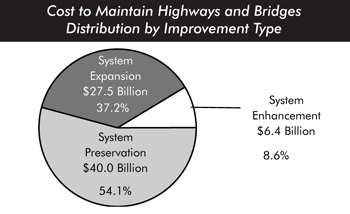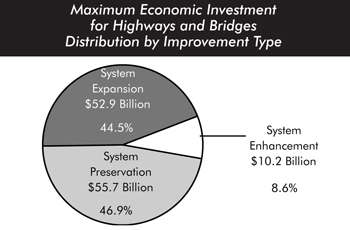
Capital Investment Requirements: Highway and Bridge
The Cost to Maintain Highways and Bridges represents the investment required by all levels of government so that critical indicators of overall conditions and performance in the year 2022 will match their year 2002 values. For bridge preservation, it represents the level of investment required to maintain the existing level of bridge deficiencies in constant dollar terms. For system expansion and pavement preservation, it represents the investment required to prevent average highway user costs (including travel time costs, vehicle operating costs, and crash costs) from rising in the future.

Agency costs, such as maintenance, and societal costs, such as emissions, are also considered in the analysis, but are not included in the calculation of the maintain user cost performance goal.
The average annual investment required over the 20-year period 2003–2022 for the Cost to Maintain Highways and Bridges is projected to be $73.8 billion. The two investment scenarios take into account the impact of existing trends in the deployment of operations strategies and technologies, including certain types of intelligent transportation systems investments. This has the primary effect of reducing the estimated level of investment required to reach a given performance target, such as maintaining user costs. As is noted on the previous page, the investment analyses do not account for the impact that broader adoption of congestion pricing could have on delaying or reducing future investment requirements.
The Maximum Economic Investment (Cost to Improve) scenario represents the investment by all levels of government required to implement all cost-beneficial improvements on highways and bridges. The average annual cost of this scenario is projected to be $118.9 billion. This level of investment would address the existing backlog of highway ($398 billion) and bridge ($63 billion) deficiencies, as well as new deficiencies as they arise during the 20-year period, when it is cost-beneficial to do so. Note that this projection implicitly assumes the continuation of current tax and fee structures. As pointed out on the preceding page, shifts in financing mechanisms could impact these results.
System preservation improvements make up 46.9 percent of the Maximum Economic Investment scenario. This includes all capital investment aimed at preserving the existing pavement and bridge infrastructure, such as resurfacing, rehabilitation, and reconstruction. This does not include the costs of routine maintenance.
Investment requirements for system expansion make up 44.5 percent of the Maximum Economic Investment scenario. The remaining 8.6 percent is not directly modeled; this represents the current share of capital spending on system enhancements such as safety, traffic control, and environmental investments.


